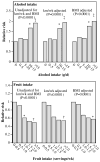Effects of diet, physical activity and performance, and body weight on incident gout in ostensibly healthy, vigorously active men
- PMID: 18469274
- PMCID: PMC4090353
- DOI: 10.1093/ajcn/87.5.1480
Effects of diet, physical activity and performance, and body weight on incident gout in ostensibly healthy, vigorously active men
Abstract
Background: Physical activity and cardiorespiratory fitness are not currently recognized as factors related to preventing gout, nor are risk factors for gout in physically active men well understood.
Objective: The objective was to identify risk factors for gout in ostensibly healthy, vigorously active men.
Design: Incident self-reported gout was compared with baseline diet, body mass index (BMI; in kg/m(2)), physical activity (in km/d run), and cardiorespiratory fitness (in m/s during 10-km footrace) prospectively in 28,990 male runners.
Results: Men (n = 228; 0.79%) self-reported incident gout during 7.74 y of follow-up. The risk of gout increased with higher alcohol intake [per 10 g/d; relative risk (RR): 1.19; 95% CI: 1.12, 1.26; P < 0.0001], meat consumption (per servings/d; RR: 1.45; 95% CI: 1.06, 1.92; P = 0.002), and BMI (RR: 1.19; 95% CI: 1.15, 1.23; P < 0.0001) and declined with greater fruit intake (per pieces/d; RR: 0.73; 95% CI: 0.62, 0.84; P < 0.0001), running distance (per km/d; RR: 0.92; 95% CI: 0.88, 0.97; P < 0.001), and fitness (per m/s; RR: 0.55; 95% CI: 0.41, 0.75; P < 0.0001). The RR per 10 g alcohol/d consumed as wine (1.27; P = 0.002), beer (1.19; P < 0.0001), and mixed drinks (1.13; P = 0.18) was not significantly different from each other. Men who consumed > 15 g alcohol/d had 93% greater risk than abstainers, and men who averaged > 2 pieces fruit/d had 50% less risk than those who ate < 0.5 fruit/d. Risk of gout was 16-fold greater for BMI > 27.5 than < 20. Compared with the least active or fit men, those who ran > or = 8 km/d or > 4.0 m/s had 50% and 65% lower risk of gout, respectively. Lower BMI contributed to the risk reductions associated with distance run and fitness.
Conclusion: These findings, based on male runners, suggest that the risk of gout is lower in men who are more physically active, maintain ideal body weight, and consume diets enriched in fruit and limited in meat and alcohol.
Conflict of interest statement
The author had no personal or financial conflict of interest.
Figures



Similar articles
-
Independent effects of cardiorespiratory fitness, vigorous physical activity, and body mass index on clinical gallbladder disease risk.Am J Gastroenterol. 2008 Sep;103(9):2239-47. doi: 10.1111/j.1572-0241.2008.01944.x. Epub 2008 Jul 12. Am J Gastroenterol. 2008. PMID: 18637096 Free PMC article.
-
Prospective study of incident age-related macular degeneration in relation to vigorous physical activity during a 7-year follow-up.Invest Ophthalmol Vis Sci. 2009 Jan;50(1):101-6. doi: 10.1167/iovs.08-2165. Epub 2008 Jun 19. Invest Ophthalmol Vis Sci. 2009. PMID: 18566466 Free PMC article.
-
Prospective epidemiological cohort study of reduced risk for incident cataract with vigorous physical activity and cardiorespiratory fitness during a 7-year follow-up.Invest Ophthalmol Vis Sci. 2009 Jan;50(1):95-100. doi: 10.1167/iovs.08-1797. Epub 2008 Apr 11. Invest Ophthalmol Vis Sci. 2009. PMID: 18408175 Free PMC article.
-
Relationship of incident glaucoma versus physical activity and fitness in male runners.Med Sci Sports Exerc. 2009 Aug;41(8):1566-72. doi: 10.1249/MSS.0b013e31819e420f. Med Sci Sports Exerc. 2009. PMID: 19568204 Free PMC article.
-
Risk factors for gout and prevention: a systematic review of the literature.Curr Opin Rheumatol. 2011 Mar;23(2):192-202. doi: 10.1097/BOR.0b013e3283438e13. Curr Opin Rheumatol. 2011. PMID: 21285714 Free PMC article. Review.
Cited by
-
A combination of red and processed meat intake and polygenic risk score influences the incidence of hyperuricemia in middle-aged Korean adults.Nutr Res Pract. 2024 Oct;18(5):721-745. doi: 10.4162/nrp.2024.18.5.721. Epub 2024 Sep 23. Nutr Res Pract. 2024. PMID: 39398885 Free PMC article.
-
Dietary Carbohydrates, Genetic Susceptibility, and Gout Risk: A Prospective Cohort Study in the UK.Nutrients. 2024 Aug 28;16(17):2883. doi: 10.3390/nu16172883. Nutrients. 2024. PMID: 39275199 Free PMC article.
-
Consumption of Total and Specific Alcoholic Beverages and Long-Term Risk of Gout Among Men and Women.JAMA Netw Open. 2024 Aug 1;7(8):e2430700. doi: 10.1001/jamanetworkopen.2024.30700. JAMA Netw Open. 2024. PMID: 39196557 Free PMC article.
-
Association between physical activity and the prevalence of gout among patients with type 2 diabetes mellitus and hyperuricemia: a two-center population-based cross-sectional study.Clin Rheumatol. 2024 Sep;43(9):2955-2961. doi: 10.1007/s10067-024-07081-5. Epub 2024 Jul 26. Clin Rheumatol. 2024. PMID: 39060811 Free PMC article.
-
Global burden and epidemic trends of gout attributable to high body mass index from 1990 to 2019.Arch Med Sci. 2024 Jan 18;20(1):71-80. doi: 10.5114/aoms/175469. eCollection 2024. Arch Med Sci. 2024. PMID: 38414454 Free PMC article.
References
-
- Pascual E. Hyperuricemia and gout. Curr Opin Rheumatol. 1994;6:454–8. - PubMed
-
- Roubenoff R, Klag MJ, Mead LA, Liang KY, Seidler AJ, Hochberg MC. Incidence and risk factors for gout in white men. JAMA. 1991;266:3004–7. - PubMed
-
- Campion EW, Glynn RJ, DeLabry LO. Asymptomatic hyperuricemia. Risks and consequences in the Normative Aging Study. Am J Med. 1987;82:421–6. - PubMed
-
- McCarty DJ. Gout without hyperuricemia. JAMA. 1994;271:302–3. - PubMed
Publication types
MeSH terms
Grants and funding
LinkOut - more resources
Full Text Sources
Medical
Research Materials
Miscellaneous


